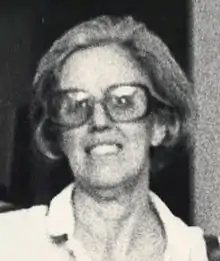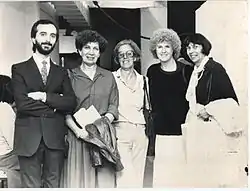Hilda López
Hilda López (27 September 1922 – 2 June 1996[1]) was a Uruguayan artist of outstanding pictorial production and strong personality, committed to the culture and artistic expression of her country.[2]
Hilda López | |
|---|---|
 | |
| Born | 27 September 1922 Montevideo, Uruguay |
| Died | 2 June 1996 (aged 73) Montevideo, Uruguay |
| Occupation | Plastic artist, painter, sculptor |
| Spouse(s) | Alberto Angenscheidt |
Biography
Hilda López was born in Montevideo in 1922, and that same year her family settled in Mataojo, Lavalleja Department, to attend to her father's business in that town.
In 1941 she entered the School of Plastic Arts of the Universidad del Trabajo in Montevideo, where she received painting lessons with Manuel Rosé and engraving with Guillermo Rodríguez. In 1952 she entered the workshop of Vicente Martín, and in 1958 she began to work with Lino Dinetto, strengthening her artistic training.[3]
In 1946 she married Alberto Angenscheidt, with whom she had two children, Eduardo and Virginia.
In 1960 López held her first solo exhibition at the Zaffaroni Gallery. From that moment on she participated in numerous exhibitions and received official awards for her works that became part of the country's public collections.[4]

Spanish sculptor Jorge Oteiza's presence in Montevideo had great influence on her work. His theories about Romero Brest's vacuum aesthetics and informalism prompted Hilda to arrive at her own plastic universe.[1] Her series Streets and inlets of Montevideo, exhibited in Washington in 1961, received a glowing critique from Frank Getlein in The Sunday Star.[5]
In 1964 López traveled to Portugal accompanying an exhibition of Uruguayan artists, where she stayed for a time and had a stormy relationship with the Portuguese painter Henriques Tavares. When the relationship ended, she returned to Montevideo.[6]
In 1965 she assembled the Uruguayan submission to the São Paulo Art Biennial. Her social and political activity was intense. She participated in the occupation of the Municipal Subway in protest of the appointment of representatives of the Municipal Salon of Plastic Arts, and in 1972 she participated in the reconstruction of Section 20 of the Communist Party in the Paso Molino neighborhood.
In 1973, with the closure of official artistic training courses by the de facto government, López began to teach. Her workshop, as well as those of Guillermo Fernández, Nelson Ramos, and Hugo Longa, persevered in difficult times and were decisive in the formation of the next generation of Uruguayan artists, achieving the continuity of the national artistic process during the dictatorial period. In 1986 she made a mural in stone and cement in homage to the victims of the dictatorship at the Central Headquarters of the Communist Party of Uruguay.
Work
The work of Hilda López is characterized by her great mastery of technical resources used with versatility in expressionist compositions of denunciation and testimony of her time.
The series created by the artist mark times in the life of her country. Grafías (1963) shows her dexterity and temperament in ink on paper. Retratos y Coral (1978) comprises works in oil and charcoal, portraits of friends and colleagues symbolically emblematic. Los Adioses (1978) shows abandoned suitcases that evoke the melancholy of the uprooting caused by exile. Pueblos (1981) denotes the human emptiness, and Campo (1983) the social hardships of the interior of the country. El problema principal es la pobreza (1988) rounds off a testimonial sequence of the painful period of the military dictatorship in her country.[1]
The series made in 1962 on large format canvases used planographic ink, filling in her creative intention through expressive gesture. With great craft in the drawing, her works on paper, using ink on paper with nib, rice cane, brush, or spatula, was defined by the artist as "an understanding with space". The ambiguous character between figuration and abstraction recorded by her works generate evocative spaces of melancholy, uprooting, and reflection.
One of her best-known works, Autorretrato con golilla roja, made in 1978 and now part of the collection of the National Museum of Visual Arts, is defined in its expressive composition by the cutting red spot of the ruff, on the monochromatism of the figure. The symbolic climate of the work reflects the situation that her country was experiencing at that time. In the series Los Adioses and Pueblos, her informalist gestures are transformed into subtlety and line suggestion. Her work transits the border between figuration and abstraction, with a palette of asordinated colors, almost monochromatic, that alludes to oppression, jail, exile, and the fear to which Uruguayan society was subjected in times of dictatorship.[3]
Expositions
- 1959: 23rd National Salon and 11th Municipal Salon
- 1960: Individual exhibition at Galería Zaffaroni
- 1961: Arcobaleno Award, Punta del Este
- 1961: Instituto Di Tella, Buenos Aires
- 1961: Pan American Union, Chicago
- 1962: 1st Córdoba Biennial, Argentina
- 1962: Algunos pintores abstractos, Center of Arts and Letters
- 1963: Grafías 63, Amigos del Arte, Montevideo
- 1963: Joint exhibit with María Freire and Amalia Nieto at the Círculo de Bellas Artes
- 1964: 7 artistas de Uruguay, Galería Divulgaçao, Lisbon, Portugal
- 1965: São Paulo Art Biennial, Brazil
- 1965: Galería Sudarmericana, New York
- 1966: Uruguayan Center of Cultural Promotion, Galería de la Ciudadela, Montevideo
- 1967: Galería U, Montevideo
- 1969: Urbanismo, Galería Portón de San Pedro, Montevideo
- 1976: Galería Alcali, Montevideo
- 1978: Retratos, Alianza Francesa, Montevideo
- 1979: Los Adioses, Cinemateca Uruguaya
- 1981: Pueblos, Galería Latina, Montevideo
- 1983: Campo, Galería Latina, Montevideo
- 1988: Retrospective at Cátedra Alicia Goyena, Montevideo
- 1988: El problema principal es la pobreza, installation at Cinemateca Uruguaya
- 1991: Rostros, Rastros, Restos, Galería Latina, Montevideo
Awards
- Acquisition Award, 12th Municipal Salon, Montevideo (1960)
- Acquisition Award, 13th Municipal Salon, Montevideo (1961)
- Acquisition Award, 14th Municipal Salon, Montevideo (1962)
- Acquisition Award, 15th Municipal Salon, Montevideo (1967)
References
- Bandrymer, Sonia (2012). "Hilda López" (in Spanish). DNC-MEC. Retrieved 6 December 2017.
- Abbondanza, Jorge (16 September 2009). "Se inaugura hoy valiosa muestra de Hilda López" [Today, a Valuable Exhibition by Hilda López Opens]. El País (in Spanish). Retrieved 6 December 2017.
- Mantero, Gerardo (December 2009). "Hilda López: Entre el rigor y la emoción" [Hilda López: Between the Rigor and the Emotion] (PDF). La Pupila (in Spanish). Vol. 2 no. 11. pp. 14–19. Retrieved 6 December 2017.
- "Hilda López" (in Spanish). National Museum of Visual Arts. Retrieved 6 December 2017.
- Larnaudie, Olga (2008). Calles y puertos: Un camino hacia la abstracción [Streets and Ports: A Path to Abstraction] (PDF). Nuevas Vías de Acceso III (in Spanish). National Museum of Visual Arts. pp. 52–56. Retrieved 6 December 2017.
- Di Maggio, Nelson (21 September 2009). "Hilda López en Portugal". LaRed21 (in Spanish). Retrieved 6 December 2017.